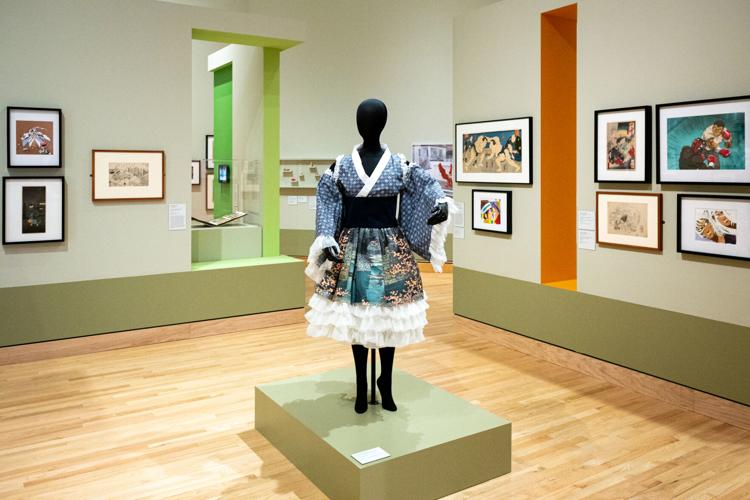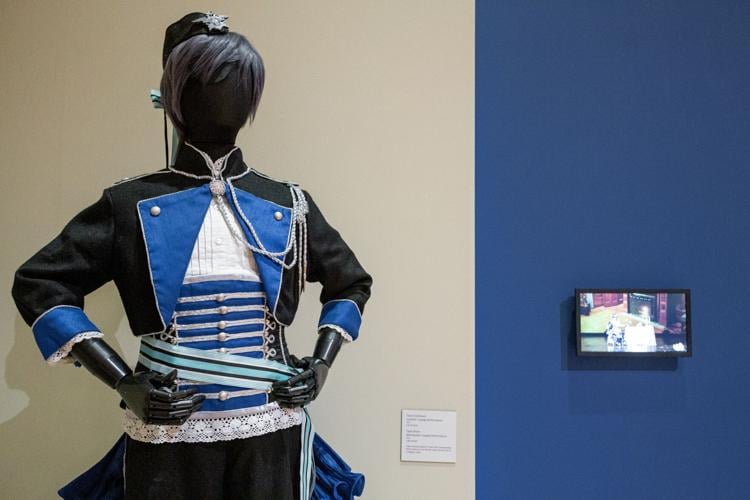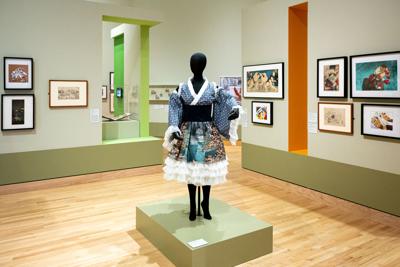WILLIAMSTOWN — On a quick pass you might think you can pin down the dress on display in the center of the exhibit — something Japanese, a kind of kimono. Look closer and you can see more of what is happening. There are two distinct patterns — an abstract pattern on top and a print of cherry blossoms on the bottom — but it is fringed all around with white ruffles, like you might see in a European dress from another century. Read the label and learn it belongs to a Japanese subculture within a subculture called “Wa Lolita,” a somewhat subversive fashion concept that mixes European schoolgirl uniforms with traditional Japanese designs. You’ll also note it was created by a designer from Argentina.
It is a carefully layered set of things and signals, using many means of reproduction and distribution, and fits a pattern explored in “Repro Japan: Technologies of Popular Visual Culture” at the Williams College Museum of Art through March 19. Taking off from how Japanese visual culture has spread around the world, the show includes printed images, textiles, photographs, clothing, all the way to manga and anime and 3D printing.
“The show is focused on technology as an enabler of popular culture, and an engine for transforming and continuing culture over decades and centuries in different times and places,” said Christopher Bolton, a professor of comparative and Japanese literature at Williams who is the coordinating curator of the exhibit.
It begins in a specific time and place, the Edo period in Japan beginning around 1600 when Japan benefited from new trade networks and growing cities with an emerging mass audience ready to buy and support products made possible by advancements like woodblock printing and mass-produced textiles. And it was a time when the country was largely closed to Westerners.
“Art developed in that period along a completely different evolutionary path than in the West,” Bolton said. “It has a novelty to us as a Western audience still today because it looks different and makes us literally see things in a different way.”
It was a time of innovation and experiment, when textiles were no longer only laboriously reproduced by hand, but could be reproduced with stencils, an assortment of which are on display along with a few of the fabrics they produced. There are also several woodblock prints from a variety of masters through the years, highlighting the evolution of carving, use of inks and colors, and perspectives over time.
From its starting point in the Edo period, the show widens its focus to include entire other realms of cultural production, always holding a thread of recurring themes — how to depict hair and how it moves, the use of mirrors and light, or how colors and images are layered in clothing — to “show what changes and what stays same as you jump from one medium to another,” Bolton said.
Among the fields explored are the world of manga comics and anime cartoons, which have built up very deep and formidable fan cultures. The exhibit can only glancingly approach the subject, and Bolton said the intention is that visitors with no knowledge about these worlds can still discern the patterns and connections there, while it still remains “responsible, faithful, and accurate” for those who are deeply involved in them.

During Japan’s Edo period, from 1603–1868, the growth of urban audiences and new popular entertainments developed in tandem with new printing technologies. This resulted in the rise of new forms of visual culture —including color woodblock prints and printed textiles — that could be mass produced, transformed, and consumed.
All the themes are pulled together in the world of cosplay, the practice of fan’s re-creating costumes and imagery from the work and put them on display. Here, that means two meticulously crafted costumes that show how many different ideas can be layered in one outfit.
One is a kind of cadet uniform, in black and bright blue, of a type that would have been worn by the character Ciel Phantomhive from the “Black Butler” anime series. It began as an image in a manga comic, a Japanese interpretation of style from Victorian England, that then become an anime series you can now find on Netflix, and here re-created as actual clothing by a fan who lives in Montana. It exists not just as an object in the museum before you, but also on a nearby screen showing a live performance at a cosplay conference in Nagoya, Japan.
And while there are the objects themselves, shown as intended as naturally as possible, another part of the show looks at how photographer Eron Rauch shows behind-the-scenes images of how the looks were created.
Rauch is one of several co-curators who brought their perspectives and expertise to specific aspects of the show. Bolton began thinking about the show about six years ago, and brought in help, including Diana Tolin on cosplay, and WCMA’s Curator for Contemporary Art Lisa Dorin to choose the contemporary art. Panalee Maskati, a Williams student, researched the prints and textile stencils.
“The original vision of the show was mine, but by the end we were executing the more specific visions of the individual curators, and the arguments they wanted to make,” Bolton said.
The physical layout of the show reflects these overlapping stories. Designer David Gürçay-Morris arranged the walls with a carefully-balanced color palette that highlights connection, as well as carefully placed cutouts that let you see through points of the show and how they overlap. Try to find the point in the exhibit where you can see the dress from Argentina — designed by Triana Martinez Dufour — where you can see the the 19th-century cherry blossom print she used for the bottom, and then turn your head and see the stencil that she imitated for the top.

A cosplay outfit, fashioned in the style of a"Black Butler" anime character is one example of technology's lasting impact on popular culture in Japan.
Although technological innovations are a steady backbeat of the show, it largely avoids big historical moments like Japan’s “opening” to the west in 1868, or World War II and its aftermath. But it inevitably comes into view in a section about 19th-century photography, when this new technology arrived from the West with a number of imperialist presumptions already locked in.
This section, curated by Wei (Maggie) Wu, isn’t a straightforward one-direction either. There are photos from Western photographers that appropriate Japanese prints, like using mirrors to shift perspective. And it recurs in specific subjects, like the Kintai Bridge, with its thick stone pillars and graceful wooden pathway that are a striking way to depict depth and distance. It recurs again and again in prints, photos, postcards, and a travel album that belonged to a traveler from Philadelphia in around 1900.
While largely contained in one gallery, another room takes the show’s themes right into the present. It is a workshop space that looks at the details of how this layering physically works, in this case through adding layers of paint for a woodblock print, or layers of animation for anime cels to capture motion and impact, and a 3D printer working on plastic netsuke fobs, that were originally exquisitely hand-carved jewelry fobs that have been adapted in a low-cost way.
Altogether the exhibit’s objects tell a story about complexity and interconnection. “Any one work is the product of different cultures, different media, and different times coming together,” Bolton said.






